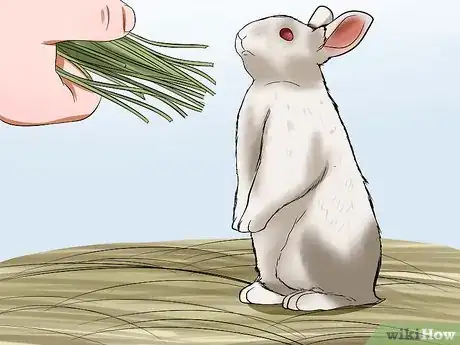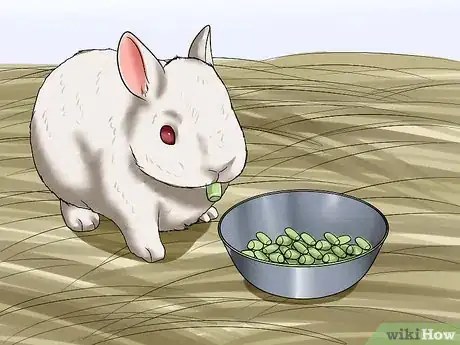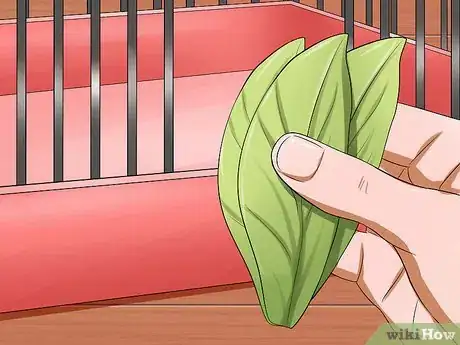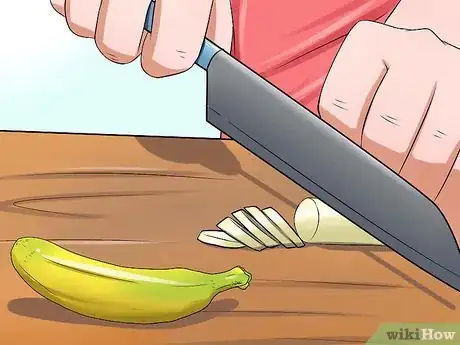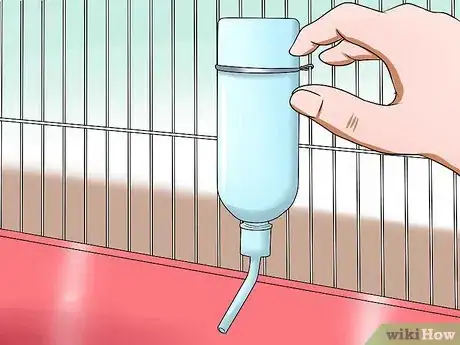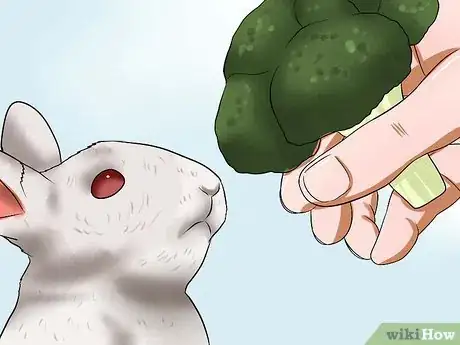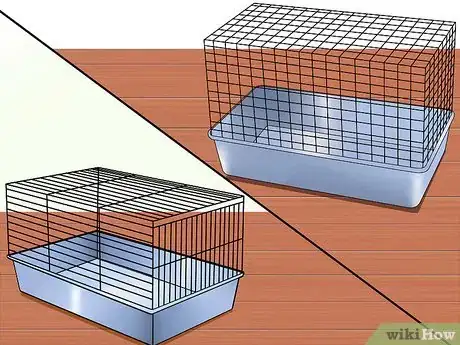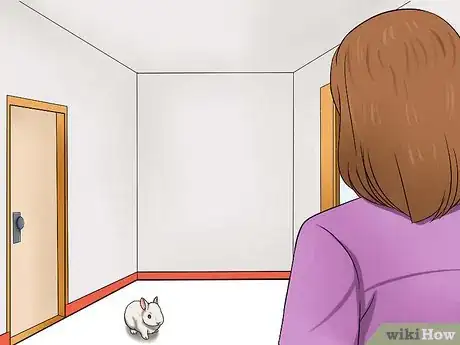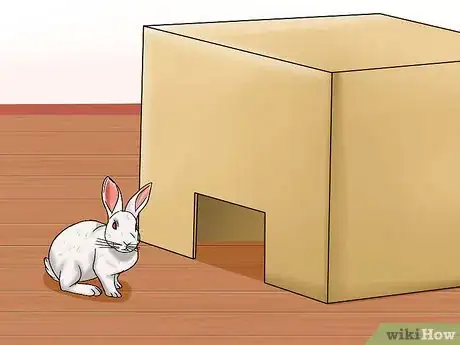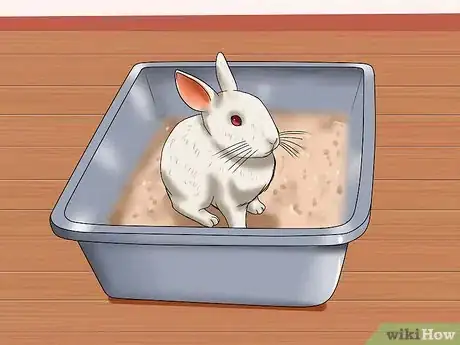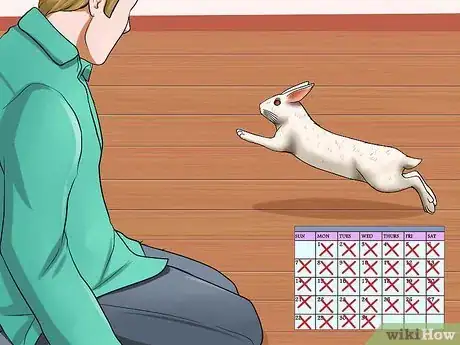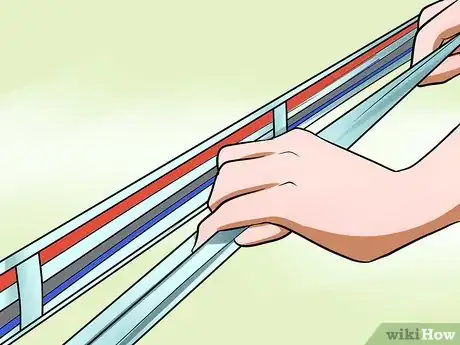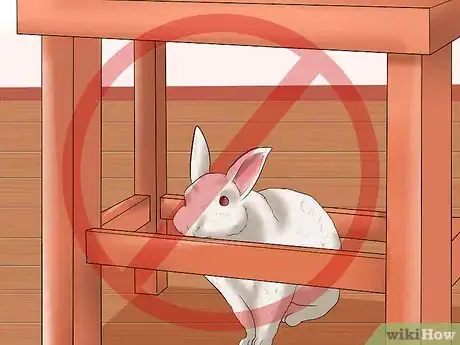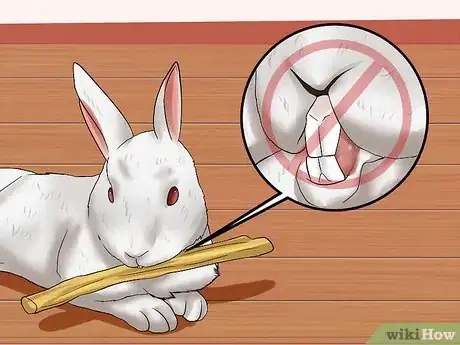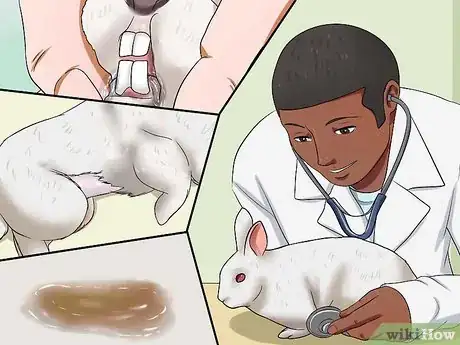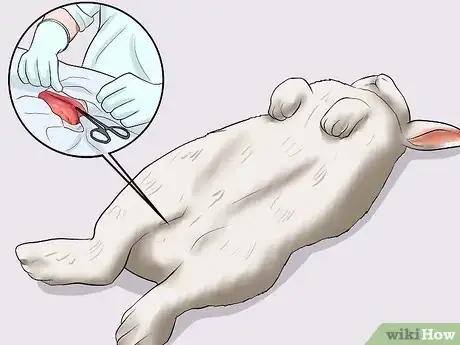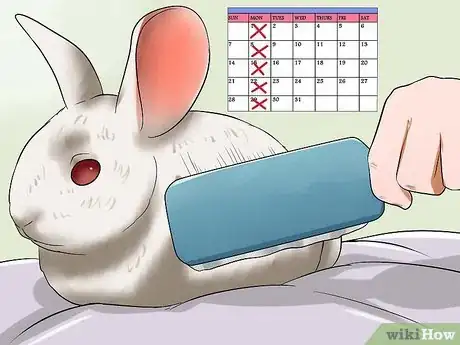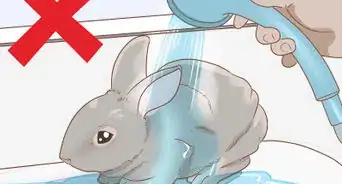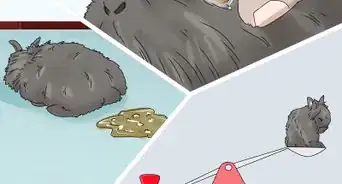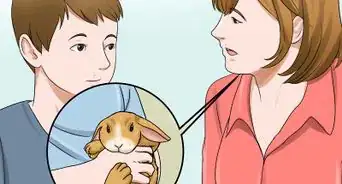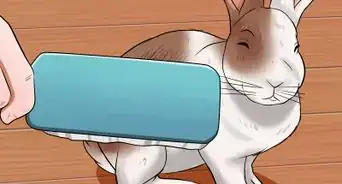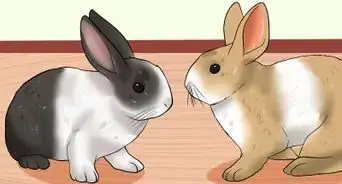This article was co-authored by Pippa Elliott, MRCVS. Dr. Elliott, BVMS, MRCVS is a veterinarian with over 30 years of experience in veterinary surgery and companion animal practice. She graduated from the University of Glasgow in 1987 with a degree in veterinary medicine and surgery. She has worked at the same animal clinic in her hometown for over 20 years.
There are 10 references cited in this article, which can be found at the bottom of the page.
wikiHow marks an article as reader-approved once it receives enough positive feedback. In this case, 91% of readers who voted found the article helpful, earning it our reader-approved status.
This article has been viewed 24,959 times.
Florida rabbits were first bred in the 1960s to be lab animals, but they are now thought of as great pets and show animals as well.[1] [2] These rabbits are all white with red eyes, so they have a distinct appearance.[3] If you have a Florida white rabbit, then you will need to provide the right types of food, housing, exercise, and veterinary care to keep your pet happy and healthy.
Steps
Feeding Your Florida White Rabbit
-
1Provide lots of hay for your Florida white rabbit. Hay is essential for the health and well-being of your Florida white rabbit. It will be her main source of nutrition and it helps to wear down her teeth as well.[4] Provide unlimited hay to your Florida white rabbit every day. Give her new fresh hay least once per day and check now and then to see if she needs more.
- Timothy hay is a good choice for Florida white rabbits.
-
2Feed plain pellets to your Florida white rabbit. Plain pellets that are meant for rabbits will also give your rabbit some good nutrition, but this is an extra item, not a staple. Give your Florida white rabbit between about 1/8 to ¼ cup of pellets per day. If your rabbit is having trouble gaining weight or if she is larger than average, then she may need more. Check with your veterinarian for a recommendation based on your rabbit’s size and other needs.[5]Advertisement
-
3Put a few dark leafy greens in your Florida white rabbit’s cage. Rabbits like dark leafy greens, so make sure that you place a couple of leaves in your rabbit’s cage every day. Some good leafy green choices for your Florida white rabbit include:[6]
- basil
- collard greens
- kale
- mustard greens
- parsley
-
4Treat your Florida white rabbit to some crunchy things. Rabbits like crunchy fruits, veggies, and seeds, so try to offer one of these treats every day. Some good treat items for your Florida white rabbit include:[7]
- Apple slices
- Banana slices
- Carrot slices
- Hulled sunflower seeds
-
5Give your Florida white rabbit a sipper bottle of water. Rabbits always need to have access to fresh, clean water. Sipper bottles are ideal because they will not spill or get contaminated with dirt or other debris. Refill your rabbit’s water bottle as needed and change the water once per day.[8]
-
6Give your rabbit certain foods in moderation. There are certain foods that may make your Florida white rabbit sick if he eats them too often. Foods you should only give your rabbit on occasion include:[9]
- Broccoli
- Brussel sprouts
- Cabbage
- Cauliflower
- Spinach
- Corn
Preparing Your Florida White Rabbit’s Cage
-
1Select an appropriate cage. Florida white rabbits are smaller than some breeds, but they still need room to hop and play. Your rabbit will need a cage that is 30 inches long by 24 inches wide by 18 inches high or larger.[10] Avoid wire bottom cages because these can injure your rabbit. Go with a solid metal bottom cage instead.
-
2Keep your Florida white rabbit indoors. Do not keep your Florida white rabbit outside. Keeping your rabbit outside will expose her to the elements, predators, and loneliness. Rabbits that are kept outside are more easily forgotten about and neglected, and may become fearful of humans, which can be a problem for a pet rabbit. Although a cage may protect your rabbit from rain and predators, a rabbit can have a heart attack from the sight of a predator.
- However, research now indicates rabbits kept purely indoors are prone to Vitamin D deficiency which can cause dental problems and weak bones. It is a good idea to take your rabbit outside on a harness, or expose her to natural sunlight every day.
-
3Give your Florida white rabbit somewhere to hide. Rabbits seem to feel safer when they can retreat to a hiding spot, so make sure that you put a cardboard box or wooden nest box you’re your rabbit’s cage. Cardboard boxes are ideal because your rabbit can move it around, chew on it and hid inside of it.[13]
-
4Provide a litter box. Your Florida white rabbit will use a litter box if you put on in her cage. You can also place a few litter boxes around your house for her to use when she is roaming. Line the litter boxes with some newspaper and hay. Change the litter box once per day.[14]
- If you notice your rabbit is urinating in a certain corner of her cage, then move the litter box over to that corner and she should start using it.
- Do not use pine or cedar shavings as litter. The fumes can cause liver and respiratory problems for your rabbit.
Protecting Your Florida Rabbit’s Health
-
1Exercise your Florida white rabbit every day. Rabbits are active animals and they need to get at least two hours of exercise every day. Since a cage is not big enough for your rabbit to hop too far or fast, you will need to take your Florida white rabbit out of her cage to allow her to run around.[15] Make sure to supervise him during this time.
-
2Hide or cover all electrical cords. Your Florida white rabbit will chew on cords if he encounters them. Not only is this dangerous for your rabbit, it may also damage your electronic goods. To prevent your rabbit from chewing on cords, you can hide cords with hard plastic tubing, spiral wrap, or just keep them out of reach.[16]
-
3Prevent your rabbit from chewing on walls and furniture. Rabbits will chew on almost any wooden object, which includes wall trim, doors, chairs, and table legs. Your Florida white rabbit might also try to chew on loose wallpaper, carpeting, and sheetrock.[17]
- Watch your Florida white rabbit when he spends time outside of his cage and stop him if he starts chewing on something that is off limits.
-
4Give your rabbit plenty of things to chew on. A rabbit’s teeth never stop growing, so you will need to be sure that your Florida white rabbit always has something to chew on. If you do not provide things for your rabbit to chew on, then his teeth may grow too long and you may have to pay a veterinarian to trim them.[18]
- If you catch your rabbit chewing on something that is off-limits, don’t punish him. Just give him something else to chew on. For example, you can give your Florida rabbit alfalfa cubes, cotton towels, untreated pine boards, cardboard boxes, or apple branches.[19]
-
5Take your Florida white rabbit for annual veterinary checkups. Your rabbit needs to see the veterinarian once per year for a checkup. If your rabbit seems sick, then you should also take your rabbit to the veterinarian. Signs of a problem include:
- runny eyes and nose
- watery diarrhea
- not defecating
- dark red urine
- drooling
- not hopping
- fur loss
- lethargy
- fever of 105 degrees Fahrenheit or more[20]
-
6Spay or neuter your Florida white rabbit. Spay and neuter your rabbits if you do not plan to breed them. Rabbits breed fast, so they may breed out of control if not spayed and neutered. Spaying and neutering your rabbits is also a good way to protect their health. Rabbits that are not spayed and neutered may engage in hormonal behaviors, such as spraying or fighting. Female rabbits that are not spayed are also at a much higher risk of uterine cancer than those that are spayed.[21]
- Keep males and female separated if your rabbits are not spayed and neutered.
-
7Brush your Florida white rabbit once per week. Rabbits require regular brushing to remove dead hairs from their bodies. To prevent white hair from getting onto your furniture and clothes, make sure that you brush your Florida white rabbit at least once per week and more if she seems to be shedding her fur.[22]
- Never give your rabbit a bath. Rabbits do not like to get wet and being wet can even lead to hypothermia for a rabbit.
Warnings
- Do not hold your rabbit by the ears or only with your hands around the chest. Always hold your rabbit’s rear end with one hand and place your other hand under the rabbit’s chest. If you hold your rabbit the wrong way, then he may end up with a broken back.⧼thumbs_response⧽
- Rabbits make softer stools during the night, but this is not diarrhea. It is normal for rabbits to do this.⧼thumbs_response⧽
References
- ↑ http://www.fwrba.net/
- ↑ http://www.fwrba.net/history.html
- ↑ http://rabbitbreeders.us/florida-white-rabbits
- ↑ http://www.spca.org/page.aspx?pid=430
- ↑ http://www.spca.org/page.aspx?pid=430
- ↑ http://www.spca.org/page.aspx?pid=430
- ↑ http://www.spca.org/page.aspx?pid=430
- ↑ http://www.spca.org/page.aspx?pid=430
- ↑ http://www.spca.org/page.aspx?pid=430
- ↑ https://www.animalhumanesociety.org/adoption/rabbit-care
- ↑ http://www.spca.org/page.aspx?pid=430
- ↑ http://myhouserabbit.com/rabbit-care/housing-your-pet-rabbit-indoors/
- ↑ http://www.spca.org/page.aspx?pid=430
- ↑ http://www.spca.org/page.aspx?pid=430
- ↑ https://www.animalhumanesociety.org/adoption/rabbit-care
- ↑ http://rabbit.org/faq-rabbit-proofing/
- ↑ http://rabbit.org/faq-rabbit-proofing/
- ↑ http://rabbit.org/faq-rabbit-proofing/
- ↑ http://rabbit.org/faq-chewing/
- ↑ http://www.merckvetmanual.com/pethealth/exotic_pets/rabbits/routine_health_care_of_rabbits.html
- ↑ http://www.spca.org/page.aspx?pid=430
- ↑ http://rabbit.org/faq-grooming/
About This Article
If you want to care for a Florida white rabbit, you’ll need to provide it a healthy diet with plenty of hay. By giving your rabbit an unlimited supply of fresh Timothy hay, you’ll not only be providing it with most of its nutrition, but you’ll be helping it wear down its teeth. For a tasty treat, slice up crunchy fruits, veggies, and seeds like apples or carrots and put it in your rabbit’s cage. While plain rabbit pellets will give your bunny some nutrition, they aren’t essential and you should only give it 1/8 to 1/4 cup per day. For more tips from our Veterinary co-author, including how to prepare a cage for your Florida white rabbit, scroll down!
